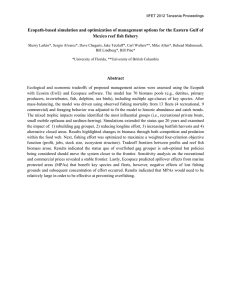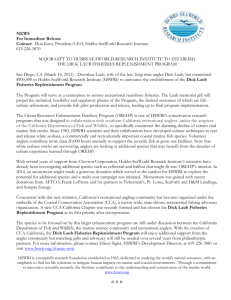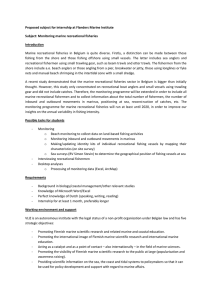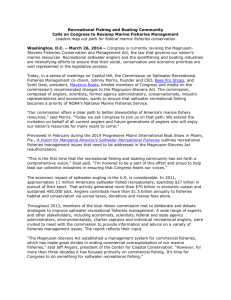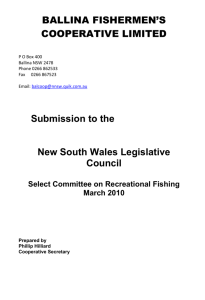Review of Recreational Fisheries Survey Methods
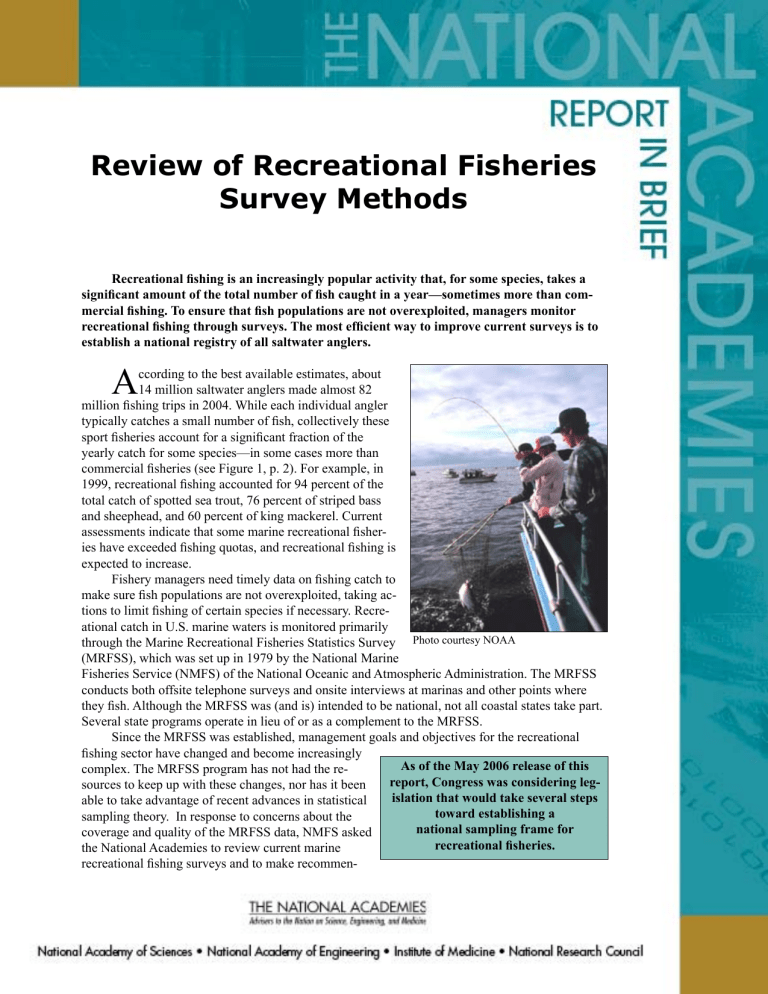
Review of Recreational Fisheries
Survey Methods
Recreational fishing is an increasingly popular activity that, for some species, takes a significant amount of the total number of fish caught in a year—sometimes more than com mercial fishing. To ensure that fish populations are not overexploited, managers monitor recreational fishing through surveys. The most efficient way to improve current surveys is to establish a national registry of all saltwater anglers.
A ccording to the best available estimates, about
14 million saltwater anglers made almost 82 million fishing trips in 2004. While each individual angler typically catches a small number of fish, collectively these sport fisheries account for a significant fraction of the yearly catch for some species—in some cases more than commercial fisheries (see Figure 1, p. 2). For example, in
1999, recreational fishing accounted for 94 percent of the total catch of spotted sea trout, 76 percent of striped bass and sheephead, and 60 percent of king mackerel. Current assessments indicate that some marine recreational fisher ies have exceeded fishing quotas, and recreational fishing is expected to increase.
Fishery managers need timely data on fishing catch to make sure fish populations are not overexploited, taking ac tions to limit fishing of certain species if necessary. Recre ational catch in U.S. marine waters is monitored primarily through the Marine Recreational Fisheries Statistics Survey
(MRFSS), which was set up in 1979 by the National Marine
Photo courtesy NOAA
Fisheries Service (NMFS) of the National Oceanic and Atmospheric Administration. The MRFSS conducts both offsite telephone surveys and onsite interviews at marinas and other points where they fish. Although the MRFSS was (and is) intended to be national, not all coastal states take part.
Several state programs operate in lieu of or as a complement to the MRFSS.
Since the MRFSS was established, management goals and objectives for the recreational fishing sector have changed and become increasingly complex. The MRFSS program has not had the re sources to keep up with these changes, nor has it been able to take advantage of recent advances in statistical sampling theory. In response to concerns about the coverage and quality of the MRFSS data, NMFS asked the National Academies to review current marine recreational fishing surveys and to make recommen -
As of the May 2006 release of this report, Congress was considering leg islation that would take several steps toward establishing a national sampling frame for recreational fisheries.
-
Figure 1. Top Ten Rec reational Species Versus
Commercial Harvest for 2004. Comparisons between the top ten spe cies in descending order of abundance by weight for U.S. recreational fish harvests and commercial landings. The figure does not include data for
Alaska and Texas because no NMFS recreational surveys are conducted in those states (National
Oceanic and Atmospheric
Administration, 2005,
Fisheries of the United
States: 2004. Silver
Spring, MD).
dations for improvements and possible alternative approaches.
The report finds that current survey methods are inadequate to provide the quality and timeliness of data necessary to manage recreational fisheries. The report concludes that the establishment of a compre hensive, universal sampling frame with national cov erage—most likely in the form of a national registry of saltwater anglers—would be the most efficient way to improve the quality and quantity of data used to assess recreational fishing.
Improving How Saltwater Anglers are
Surveyed
It is much more difficult to collect data on recreational fishing than on commercial fishing be cause of the large number of saltwater anglers spread throughout the country, and the many different places and ways they fish (e.g., from charter boats, private boats, private property, and so on). In addition, the telephone survey depends both on the accuracy of the angler’s memory of past fishing trips and on the angler’s willingness to provide this information to the caller. Designing a survey that will provide accurate and timely information, with good coverage and at acceptable cost, is a major challenge.
Specific challenges in conducting reliable sur veys (or sampling) include the following:
• Onsite methods fail to intercept anglers who have private access to fishing waters, or intercept them only sporadically. To compensate, fishing habits and success rates are assumed to be similar at private and public access sites.
• Reaching anglers in telephone interviews is com plicated by the increasing use of cell phones. The use of random-digit-dialing is inefficient because it reaches many households where there are no anglers. In addition, telephone surveys are restricted to coastal counties and must be adjusted (based on results from the onsite interview survey) to ac count for anglers living inland.
• Offsite sampling methods that rely on lists of saltwater anglers who buy fishing licenses are not currently feasible because of the many license exemptions based on age, residence, access points, existence of a boat license, mode of fishing, and other factors.
• Catch and release fishing (release of fish that survive capture) is increasingly common in marine recreational fisheries, but since not all fish survive after they are let go there could be additional ef fects on fish populations. Fish are often injured during capture, hence mortality may be high, in some cases exceeding 50 percent. Additional stud ies are needed to provide reliable estimates of the mortality and number of fish caught and released.
This shortcoming affects estimates of catch and total removals.
• The correct identification of fish species, especially in places with many different species, is a difficult challenge, both for anglers and for those conduct ing surveys.
Some of these shortcomings would be most efficiently resolved by the report’s recommended establishment of a national registration of all saltwater anglers. This goal could also be achieved by new and existing state saltwater license programs, if they include all anglers without exemptions panding coverage beyond anglers in coastal counties.
The report recommends that the for-hire sector of marine recreational fisheries be considered a com mercial sector for survey purposes. Charter, party, and other for-hire recreational fishing operations should be required to maintain logbooks of fish caught and released as well as of fish landed and kept. In addition, at different access points.
1 and provide appropriate contact information from anglers fishing in all marine waters, both state and federal. A salt-water fishing registry would provide a targeted survey base, eliminating current inefficiencies and ex the onsite sampling frame for the MRFSS should be to be affected by biases in the survey data that have
-
redesigned to better account for variation of catch rate
Improving Statistical Estimation in Surveys
The report concludes that the designs, sampling strategies, and collection methods of recreational fish ing surveys are not adequate for the current demands of fisheries management. Estimates of catch are likely not been sufficiently addressed. Also, procedures used to analyze the MRFSS survey results do not fully exploit recent advances in sampling theory.
The report recommends that the statistical properties of various sampling, data-collection, and data-analysis methods be determined. Assumptions should be examined and verified so that biases can be properly evaluated. An independent research group of statisticians should be employed to design new analy ses based on recent developments in sampling theory.
A greater degree of coordination between fed eral, state and other survey programs is necessary to achieve a national perspective on the status of marine recreational fisheries. Currently, many of the inde pendent surveys conducted by the states, as well as state-run surveys that are components of the MRFSS, differ in important ways, including sampling, data col lection, and preparation of estimators, from each other and from the central MRFSS. Many of the surveys conducted by state agencies (with various degrees of federal funding) suffer from the same shortcomings as do the central MRFSS surveys. As a result, most of this report’s recommendations also apply to state surveys.
Incorporating Trends in Where, When, and
Why People Fish
Good survey coverage relies on tracking data on the human dimensions of fishing, including the social and economic factors that might affect the number and location of fishing access sites. For example, develop ment can bring more people into an area, while storm damage or hurricane threats can drive people from an area. The MRFSS is not designed with human dimen sions in mind, but instead largely focuses on biologi cal factors (e.g., numbers, sizes, and kinds of fish landed).
The report recommends that an independent national trip and expenditure survey be developed to support economic valuation studies, impact analyses, and other social and attitudinal studies. The national database on marine recreational fishing sites should be enhanced to support social and economic analy sis. The data set should include site characteristics that matter to anglers, such as boat ramps, facilities, natural amenities, parking, size and type (beach, pier, launch point, and so forth). To account for changes in the number and patterns of trips and the changing characteristics of sites, a periodic updating of the data should be undertaken.
Photo courtesy NOAA
1 There is no scientific reason that a state should not continue to allow certain groups (e.g., seniors) to fish for free, as long as everyone is required to register in the universal sampling frame.
Need for Greater Program Support
The MRFSS program staff have been se verely handicapped by a lack of resources in their efforts to implement, operate, and improve the survey, including implementing the recommenda tions of earlier reviews. Despite the dedication and capabilities of the staff, they have too few resourc es, such as the lack of a Ph.D.-level mathematical statistician, to operate a national survey of such complexity. Also, the financial resources allocated to the MRFSS program are modest in comparison to the challenge of conducting an efficient and timely survey.
The MRFSS (as well as many of its com ponent or companion surveys conducted either indirectly or independently) should be redesigned to improve the effectiveness and appropriateness of its sampling and estimation procedures, its appli cability to various kinds of management decisions, and its usefulness for social and economic analyses.
After the revision is complete, provision should be made for ongoing technical evaluation and modifi cation as necessary to meet emerging management needs.
The report also suggests the existing MRFSS program be given a firm deadline linked to suf ficient program funding for implementation of this report’s recommendations. The recommended changes to the design and operation of the MRFSS program and its continued development and operation will likely require funding above cur rent levels. Additional funding will be required for a survey office devoted to the management and implementation of marine recreational surveys, including coordination between surveys conducted in various state and federal agencies.
Need for Better Communication and
Outreach
It is difficult for individual anglers to see the effects of angling on their target species and to distinguish daily and seasonal fluctuations from trends. As a result, even if a marine recreational survey is well designed and implemented, it will not fully succeed without the cooperation of anglers. If anglers understand the basic purpose of recreational fishing survey data and how those data are interpreted and used, they are more likely to have confidence in the survey and to participate and provide dependable information.
The report recommends several ways to improve outreach and communication. MRFSS scientists should advise anglers and managers on the constraints that apply to the use of the data for various purposes. Outreach and communication should be established as an integral part of the ongoing program to develop expertise and emphasize the importance of more effective dialogue and dissemination of information. Further, angler associations should be engaged as partners with survey managers through workshops, data collection, survey design, and participation in survey advisory groups.
Photo courtesy NOAA
COMMITTEE ON THE REVIEW OF RECREATIONAL FISHERIES SURVEY METHODS:
Patrick J. Sullivan (Chair), Cornell University, Ithaca, New York; F. Jay Breidt , Colorado State University,
Fort Collins; Robert B. Ditton , Texas A&M University, College Station; Barbara A. Knuth , Cornell Univer sity, Ithaca, New York; Bruce M. Leaman , International Pacific Halibut Commission, Seattle, Washington;
Victoria M. O’Connell , Alaska Department of Fish and Game, Sitka; George R. Parsons, University of Dela ware, Newark; Kenneth H. Pollock , North Carolina State University, Raleigh; Stephen J. Smith , Bedford
Institute of Oceanography, Dartmouth, Nova Scotia, Canada; S. Lynne Stokes , Southern Methodist University,
Dallas, Texas. National Research Council Staff: Christine Blackburn , Study Director, Ocean Studies Board;
David Policansky , Scholar, Board on Environmental Studies and Toxicology.
This report brief was prepared by the National Research Council based on the committee’s report.
For more information, contact the Ocean Studies Board at (202) 334-2714 or visit http:// nationalacademies.org/osb. Review of Recreational Fisheries Survey Methods is available from the National Academies Press, 500 Fifth Street, NW, Washington, D.C. 20001; (800) 624-6242; www.nap.edu.
© 2006 The National Academy of Sciences

